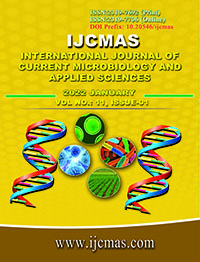


 National Academy of Agricultural Sciences (NAAS)
National Academy of Agricultural Sciences (NAAS)

|
PRINT ISSN : 2319-7692
Online ISSN : 2319-7706 Issues : 12 per year Publisher : Excellent Publishers Email : editorijcmas@gmail.com / submit@ijcmas.com Editor-in-chief: Dr.M.Prakash Index Copernicus ICV 2018: 95.39 NAAS RATING 2020: 5.38 |
The experiment was conducted in Seed science Post Graduate Laboratory, Department of Genetics and Plant Breeding, SHUATS, Prayagraj, U.P. during Rabi (2020 - 2021), in order to standardize the best treatment with organic priming treatment for specific to pearl millet Method of organic priming were evaluated by screening arrange of durations and concentration viz T0-Control, T1- Calcium chloride (5%) for 8hrs, T2- Potassium nitrate –(5%) for 8 hrs, T3- Pseudomonas fluroscens (4%) for 8 hrs, T4- Indole acetic acid (4%) for 8 hrs, T5 – Panchagavya (5%) for 8 hrs, T6 – Neem leaf extract(5%) for 8 hrs found that all the priming methods showed significance difference with the control and quality parameters the treated seeds have shown the best results T4-Indole acetic acid (4%) seed treatment was reported highest percentage of germination (85%), highest seedling length (25.09 cm) was highest fresh weight (2.16g), highest vigour index-I (2133.33), highest vigour index-II(21.74)was reported T4- Indole acetic acid (4%) and highest shoot length (14.10cm) and highest Root length (cm) was reported in T2-Potassium nitrate(5%), followed by and T2- Potassium nitrate(5%). Seed priming involves taking seed through the early stages of the germination process by exposing the seeds to various abiotic conditions. The study helps to improve the quality of seeds Priming brings all seeds to an equal point of germination, enabling fast and uniform emergence when planted Uniform emergence helps optimize harvesting efficiency which can increase yield potential.
 |
 |
 |
 |
 |